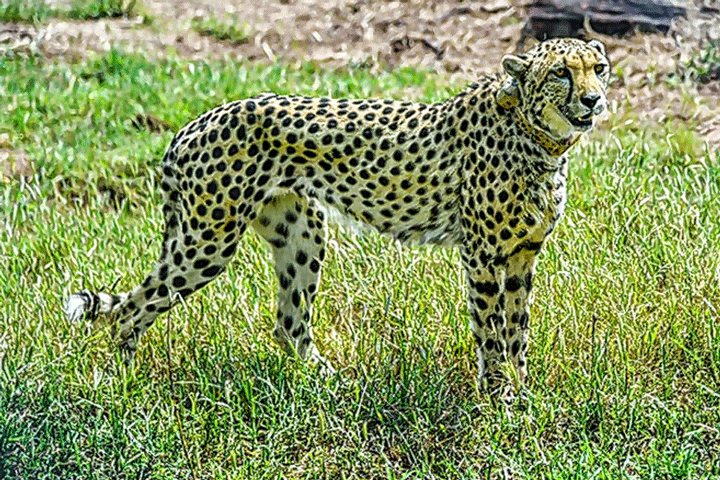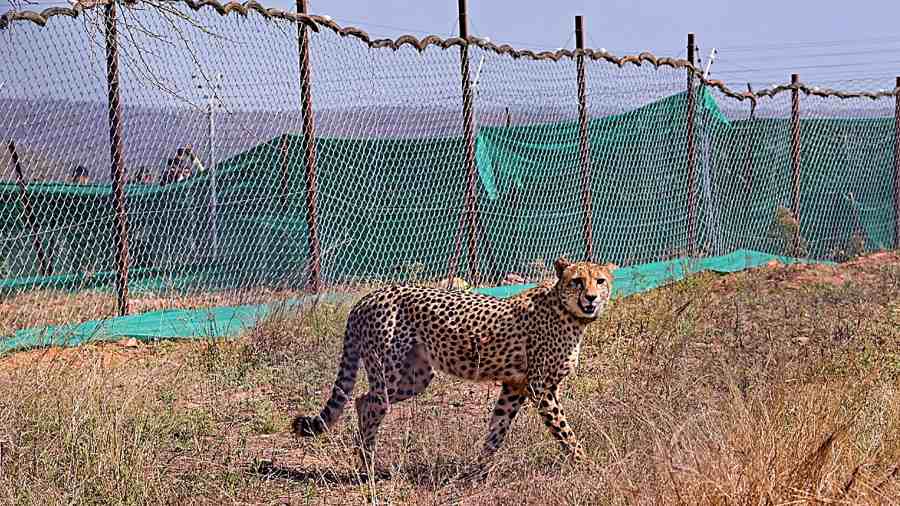Wildlife authorities are set to release five more cheetahs from fenced enclosures into open free-roaming areas of the Kuno National Park, Madhya Pradesh, before the onset of the monsoon rains in June as part of efforts to populate India with wild cheetahs.
The five cheetahs — three female and two male — will join three Namibian cheetahs released into Kuno’s open area in March and put to test competing claims among wildlife researchers about how many cheetahs Kuno’s 748sqkm can support.
The free-roaming cheetahs will be allowed to move out of Kuno and will be recaptured only if they venture into areas where they might be in “significant danger,” three wildlife experts and an official from the National Tiger Conservation Authority have said.
The 10 other cheetahs in Kuno will remain behind fenced enclosures called “acclimatisation camps” through the monsoon season, but staff will open internal gates to provide more space to the cheetahs and to allow them to mate, the experts said in a document outlining future plans. One of the 10 is a Namibian female that gave birth in March to four cubs after mating in December. She will remain in the camp where she will be able to hunt prey and raise her cubs.
The decision to release five more cheetahs emerged after experts from India and South Africa visited Kuno on April 30 to inspect the cheetahs. “All cheetahs were in good physical condition, making kills at regular intervals, and displaying natural behaviour,” the experts said in their report.
India’s environment ministry brought eight cheetahs from Namibia in September 2022 and 12 more from South Africa in February this year for its cheetah introduction project that seeks to establish clusters of cheetah populations in several wildlife reserves.
A Namibian cheetah died on March 27 from kidney disease and a South African cheetah died on April 23. An initial post-mortem study on the South African cheetah has determined heart-and-lung failure which, experts say, merely marks a terminal phase of death and not the cause. The post-mortemexam also indicated a brain haemorrhage whose cause remains unknown.
India is releasing cheetahs amid debate and uncertainty over Kuno’s cheetah-carrying capacity.
“Nobody has studied cheetahs in an Indian landscape before, so nobody can claim to know for sure what the exact cheetah carrying-capacity will be in Kuno,” said Adrian Tordiffe, a veterinary wildlife specialist at the University of Pretoria and an advisor to the project.
The cheetah introduction plan had estimated Kuno’s cheetah carrying capacity as 21. But one of four Namibian cheetahs released had moved out of Kuno and approached villages several times, prompting staff to recapture it and place it within a fenced enclosure, triggering speculation about what might happen if more cheetahs are released.
The criteria to pick five more for release included their relative ease of approachability by cheetah monitoring teams. “They should not be too skittish. If they’re very wild, they’ll be almost impossible to follow closely and difficult to recapture if they travel too far or get into trouble,” Tordiffe said.
Sections of wildlife biologists who have studied cheetahs in Africa have expressed concern that the project has disregarded the spatial requirements of cheetahs and predicted that cheetahs in Kuno will come into conflict with livestock farmers.
Bettina Wachter, an evolutionary ecologist in Germany and her colleagues predicted last month that three male cheetahs will occupy the entire Kuno and not leave space for any more territorial males which will therefore likely move outside the park’s boundaries.
But Qamar Qureshi, a senior scientist at the Wildlife Institute of India, Dehradun, and currently the chief scientist guiding the cheetah introduction project, said Wachter’s predictions are based on observations from Africa that, he said, cannot be extrapolated to India.
“Our landscape, our prey abundance, our prey distribution is different from those in Africa,” said Qureshi. “We do not have migratory prey as in Africa. Our carrying capacity will be determined by resources the cheetahs find in the local landscape.”
Qureshi said it is not surprising to see cheetahs moving across large areas soon after release. “It is just their exploratory phase. Once they get to know the landscape and its resources, they will settle down and the area they settle down will be much smaller than their exploratory area,” he said.
Qureshi and Tordiffe were among those who met in Kuno on April 30. The others included Vincent van der Merwe, an expert managing cheetah populations in South Africa and Amit Mallik, inspector general of forests with the NTCA, the environment ministry agency implementing the cheetah project.











